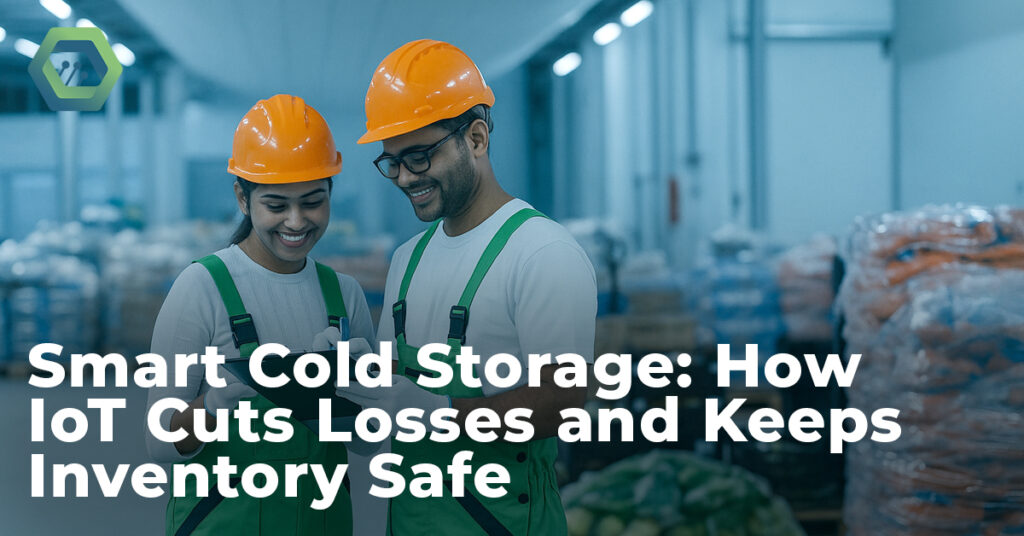In industries like food, pharmaceuticals, and logistics, maintaining the right temperature is critical. A small change in temperature can spoil goods, cause major losses, or even lead to health risks. This is where IoT in Cold Storage plays a big role.
The Internet of Things (IoT) is changing how cold storage is managed. With smart sensors, real-time data, and remote control, businesses can now prevent spoilage, improve safety, and save costs.
In this blog, we’ll explore how IoT in Cold Storage works, its benefits, use cases, and why it’s the future of safe and efficient inventory management.
What is IoT in Cold Storage?
IoT in Cold Storage uses internet-connected devices like temperature sensors, humidity trackers, and smart alarms to monitor and manage cold environments. These devices send real-time data to cloud platforms where it can be analyzed, reported, and used to trigger alerts or actions.
Whether it’s a freezer in a restaurant, a refrigerated truck, or a large warehouse, IoT solutions ensure that the temperature stays within the right range — automatically and constantly.
Why Traditional Cold Storage Fails
Before IoT, cold storage relied on manual checks or basic automation. These methods have many issues:
- Human Error: Staff may forget to check temperatures.
- No Real-Time Alerts: By the time a problem is noticed, it’s often too late.
- Lack of Data: No way to track patterns or prevent future issues.
- Wasted Inventory: Spoiled goods lead to financial loss and unhappy customers.
That’s why businesses are turning to IoT in Cold Storage to make their systems smarter and more reliable.
Key Benefits of IoT in Cold Storage
Here’s how businesses benefit by using IoT in Cold Storage:
1. Real-Time Monitoring
IoT sensors constantly check temperature, humidity, and other factors. You can see this data live from a dashboard or mobile app.
2. Instant Alerts
If the temperature goes out of range, you’ll get alerts by SMS, email, or app notifications. You can act quickly before damage happens.
3. Predictive Maintenance
IoT can predict equipment failure. For example, if a cooling unit is using more power than usual, the system can flag it for maintenance.
4. Regulatory Compliance
Many industries must meet strict storage rules. IoT in Cold Storage helps businesses maintain records and meet guidelines like FDA or FSSAI.
5. Reduce Wastage and Save Costs
Spoiled goods cost money. By preventing temperature swings, IoT in Cold Storage reduces wastage and saves you money.
6. Data Reports and Insights
IoT platforms generate reports on temperature history, equipment health, and energy use. This helps improve planning and efficiency.
Common Applications of IoT in Cold Storage
IoT in Cold Storage is being used across many sectors. Here are some real-world examples:
1. Food Industry
Restaurants, supermarkets, and warehouses use IoT to monitor refrigerators and freezers. Alerts help prevent spoilage of meat, dairy, and frozen items.
2. Pharmaceutical Supply Chain
Medicines and vaccines must stay within a strict temperature range. IoT in Cold Storage ensures they are safely stored during shipping and storage.
3. Cold Chain Logistics
From farm to store, perishable goods need temperature control. IoT trackers in refrigerated trucks give full visibility during transit.
4. Dairy and Meat Processing Plants
IoT sensors monitor large cold rooms to maintain freshness and reduce the risk of contamination.
5. Flower and Plant Storage
Even flowers need the right climate. Florists and wholesalers use IoT in Cold Storage to ensure freshness and quality.
How IoT in Cold Storage Works
Let’s break down how a typical IoT in Cold Storage system works:
- Sensors – Installed inside cold storage units to measure temperature, humidity, door status, etc.
- Gateway – Collects data from sensors and sends it to the cloud.
- Cloud Platform – Analyzes and stores the data. Triggers alerts and automation.
- Dashboard or App – Lets users view live data, reports, and control devices remotely.
- Alarms and Automation – Can turn on backup power or send alerts if there’s a problem.
IoT in Cold Storage: A Smart Investment
Investing in IoT in Cold Storage is not just about technology. It’s about protecting your products, reputation, and profits.
With rising energy costs and stricter regulations, businesses can’t afford cold storage failure. IoT makes the system reliable, transparent, and easy to manage.
And since the cost of IoT devices has gone down, even small businesses can benefit from smart cold storage solutions.
Future of Cold Storage with IoT
The future is even smarter. Here’s what’s coming next:
- AI Integration – AI will analyze data and improve cooling efficiency.
- Automated Repairs – IoT can trigger backup systems or self-fix small issues.
- Blockchain Tracking – Add transparency to the cold chain with secure data logs.
- Solar-Powered Sensors – Eco-friendly solutions for remote cold storage.
The shift toward smart storage will only grow stronger in the next few years. Businesses that adopt IoT in Cold Storage early will have a big advantage.
Final Thoughts
In today’s fast-moving world, manual cold storage management is no longer enough. IoT in Cold Storage gives you real-time control, improved safety, and data-backed decisions — all at your fingertips.
Whether you’re in food service, healthcare, or logistics, smart cold storage solutions help you stay one step ahead of risks.
OmniWOT: Your Trusted Partner in Smart Cold Storage
At OmniWOT, we offer a powerful and affordable IoT in Cold Storage solution. Our system includes long-range wireless sensors, real-time dashboards, instant alerts, and a reliable cloud platform.
We help businesses across industries monitor and manage their cold storage with ease. With OmniWOT, you can:
- Improve safety and compliance
- Save time and money
- Prevent product loss
- Get 24/7 visibility on your storage conditions
Ready to make your cold storage smart and future-ready?
Choose OmniWOT — Your partner in IoT-powered cold storage solutions.


